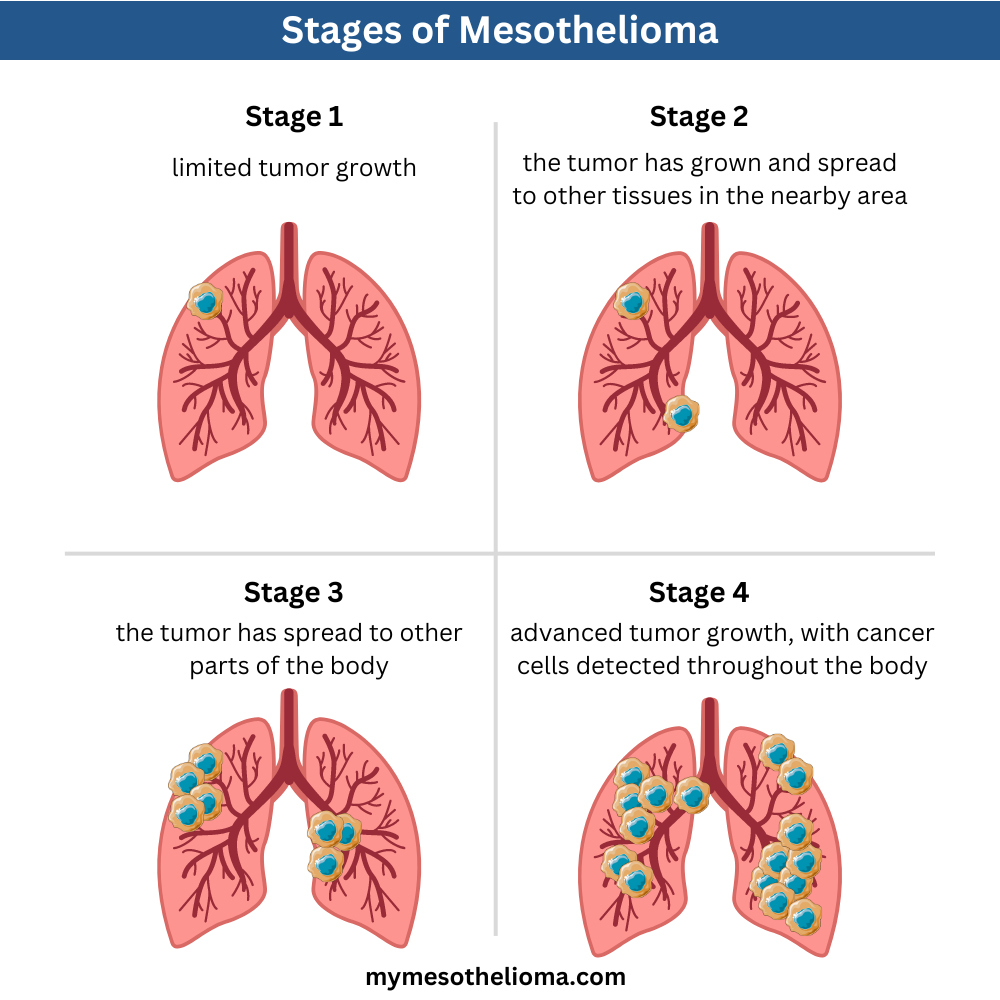Mesothelioma is a rare and aggressive type of cancer that is caused by exposure to asbestos. Pleural mesothelioma, the most common type, can occur when an individual inhales or breathes in asbestos fibers. While there is currently no known cure for this fatal cancer, medical advancements hold hope for the future of mesothelioma patients. One example is the discovery that lymph nodes located in the rib cage could be used to better stage and treat pleural mesothelioma.
The Connection Between Lymph Nodes and Cancer
Lymph nodes are part of the body’s immune system. They filter out foreign substances that travel through the lymphatic fluid to help the body fight disease and infection. Lymph nodes are used for staging all types of cancers, including mesothelioma. Staging refers to determining the stage of a cancer, or how far cancer cells have traveled or spread to other parts of the body. In general, the more advanced the stage of the cancer, the harder it is to treat.
Doctors can use lymph nodes to determine if cancer is present in part of the body. Lymph nodes in an affected area may swell or enlarge as they try to process out the cancer cells. Common areas where swollen lymph nodes occur are the neck, underarms, and groin. Even if cancer does not begin in the lymph nodes, it could spread there from someplace else by traveling through the lymph system. This is called metastasis.
To determine if cancer is in a lymph node, a doctor will conduct a biopsy. This takes a tissue sample of one or more lymph nodes and analyzes it under a microscope to find out if it contains cancer cells. If cancer cells are present in a lymph node, doctors can use this information to stage a patient’s cancer based on how far it has metastasized from the origin. Accurately staging the cancer will then inform the patient’s treatment options.
Overlooked Lymph Nodes Could Help Pleural Mesothelioma Patients
The posterior intercostal lymph nodes – located between the ribs near the spinal cord – are not traditionally used to stage any type of cancer, including pleural mesothelioma. However, on October 28, 2014, at the 15th World Conference on Lung Cancer, a presentation by Dr. Joseph S. Friedberg, MD demonstrated the benefits of including this previously overlooked set of lymph nodes in the staging and treatment of pleural mesothelioma.
Pleural mesothelioma is cancer of the mesothelial tissue known as the pleura, which is a protective membrane that covers the lungs and the inside of the chest cavity. Pleural mesothelioma is caused by exposure to asbestos. In his presentation, Dr. Friedberg detailed a retrospective study of 48 patients who were undergoing radical pleurectomy (removal of the pleura). The study found that more than half of the patients had cancer metastasized to these rib cage lymph nodes.

In some of the patients studied, the posterior intercostal lymph nodes were the only ones that contained cancer cells. The study found that patients who did not have cancer in these lymph nodes had significantly longer survival rates (about 2.5 years longer) than those who did. This, Dr. Friedberg argued, showed that the relationship between these lymph nodes and pleural mesothelioma is highly significant.
He held that the absence or presence of cancer cells in the posterior intercostal lymph nodes could help guide doctors in the staging and treatment of pleural mesothelioma. The presentation concluded with the suggestion that these lymph nodes in the rib cage become part of a revised mesothelioma staging system, and that surgeons should biopsy these lymph nodes as part of any treatment for mesothelioma that involves surgery.
What Are the Stages of Mesothelioma?
Knowing as much as possible about a patient’s condition can help a doctor plan a more effective treatment regime. One of the most important factors is the stage of the cancer. This is a key piece of information that can determine a patient’s prognosis and establish the best way to treat the cancer. The earlier the stage, the more treatment options a patient will have. For example, surgery may be an option in earlier stages but not later stages after the cancer has spread throughout the body.

Pleural mesothelioma is classified into one of four stages:
- Stage 1 – limited tumor growth, with little to no metastasis to the lymph nodes or other parts of the body. All treatment options are typically available in Stage 1. The five standard treatments for pleural mesothelioma are surgery, chemotherapy, radiation therapy, immunotherapy and targeted therapy.
- Stage 2 – the tumor has grown and spread to other tissues in the nearby area. However, the cancer has not spread beyond the chest cavity. Most treatment options should still be available in stage 2, depending on the health of the patient.
- Stage 3 – the tumor has continued to grow and has spread to parts of the body outside of the chest cavity. At stage 3, a patient may or may not be a candidate for surgery to remove tumors or cancer cells. Chemotherapy and other types of therapies may still be available.
- Stage 4 – there is advanced tumor growth, with cancer cells detected throughout the body. At this stage, treatments to stop the spread of cancer may not be available. Palliative treatments to keep the patient comfortable might be the only option.
The most common method used to stage mesothelioma is the TNM system, where T stands for Tumor size and location, N is any spread to Nearby lymph nodes, and M is Metastasis to other parts of the body. This system was created by the American Joint Committee on Cancer (AJCC). Additional letters and numbers can be added to classify a more specific stage. Stage 1 can be divided into 1A or 1B, for example, to describe exactly where cancer cells are found.
Lymph Nodes in the Rib Cage: Frequently Asked Questions
Where are lymph nodes in the rib cage?
The rib cage houses several groups of lymph nodes, playing a crucial role in your immune system’s drainage and filtering:
- Posterior intercostal lymph nodes: Tucked between the ribs near the spine, these are the most common nodes felt in the rib cage.
- Lumbar lymph nodes: Found between the diaphragm and pelvis (lumbar region), these nodes are deeper and not easily felt.
- Mediastinal lymph nodes: Located deeper within the chest cavity, these nodes drain organs like the heart and lungs and are not typically palpable.
Why do I have a lump on my rib cage?
Lumps in the rib cage can have various causes, some harmless and others requiring medical attention. Here are some possibilities:
- Swollen lymph nodes: Enlarged nodes often indicate infection, inflammation, or immune system activity. They may be tender or painless, and their size and location can offer clues to the underlying cause.
- Muscle strain or tightness: Overexertion or repetitive use can cause muscle knots or spasms, creating lumps under the skin.
- Benign cysts or lipomas: These fatty tissue growths are usually harmless and painless, though they can cause concern due to their location.
- More serious conditions: In rare cases, lumps in the rib cage can be related to cancerous tumors, though other symptoms are usually present.
When should I be concerned about a lump in my rib cage?
Seek medical attention if:
- The lump is hard, fixed, and rapidly growing.
- It’s accompanied by fever, night sweats, or unexplained weight loss.
- The lump is painful or interferes with breathing or movement.
- You have other concerning symptoms like fatigue or persistent cough.
How are swollen lymph nodes in the rib cage treated?
Treatment depends on the underlying cause:
- Infections: Antibiotics or other medications may be needed.
- Inflammation: Anti-inflammatory medication or rest may be recommended.
- Muscle strain: Physical therapy, massage, or pain medication can help.
- Benign cysts or lipomas: Observation or surgical removal in some cases.
- More serious conditions: Treatment will depend on the specific diagnosis and may involve surgery, chemotherapy, or radiation therapy.
Hope for the Future of Mesothelioma Diagnosis and Treatment
Medical and scientific breakthroughs such as evidence that the posterior intercostal lymph nodes could be used to better stage and treat pleural mesothelioma provide hope for the future. Presentations such as the one given by Dr. Friedberg in 2014 have paved the way for improved standards today in how mesothelioma cases are handled by physicians. For more information about pleural mesothelioma and your legal options as someone who has been diagnosed, contact Bailey & Glasser, LLP.

